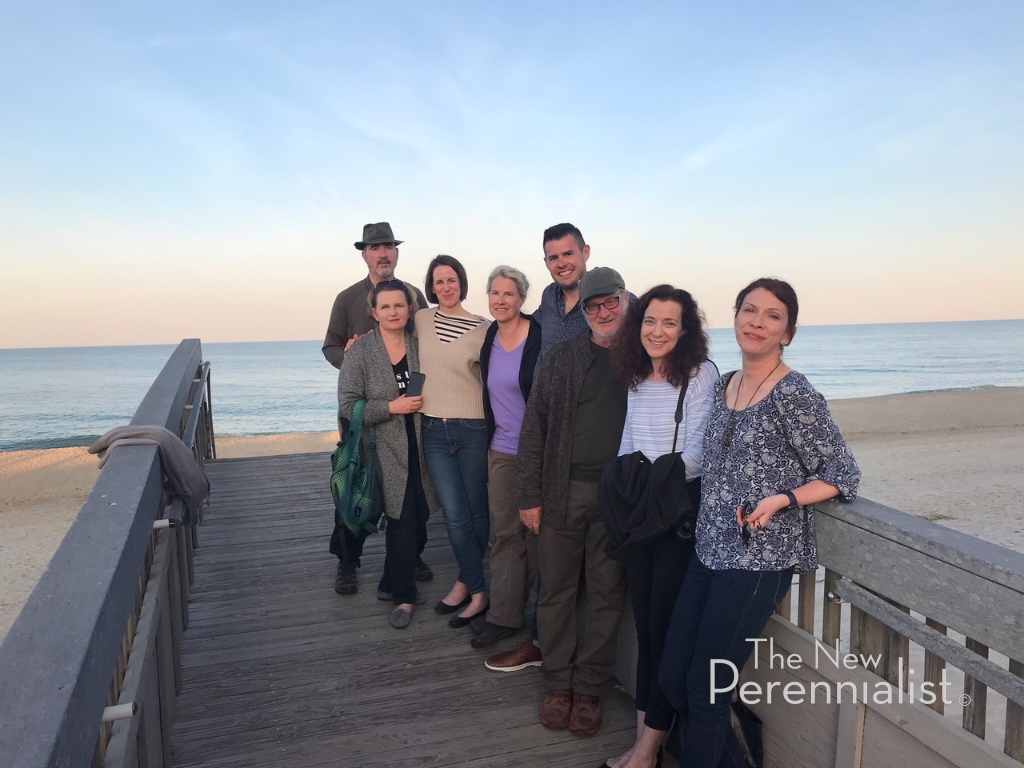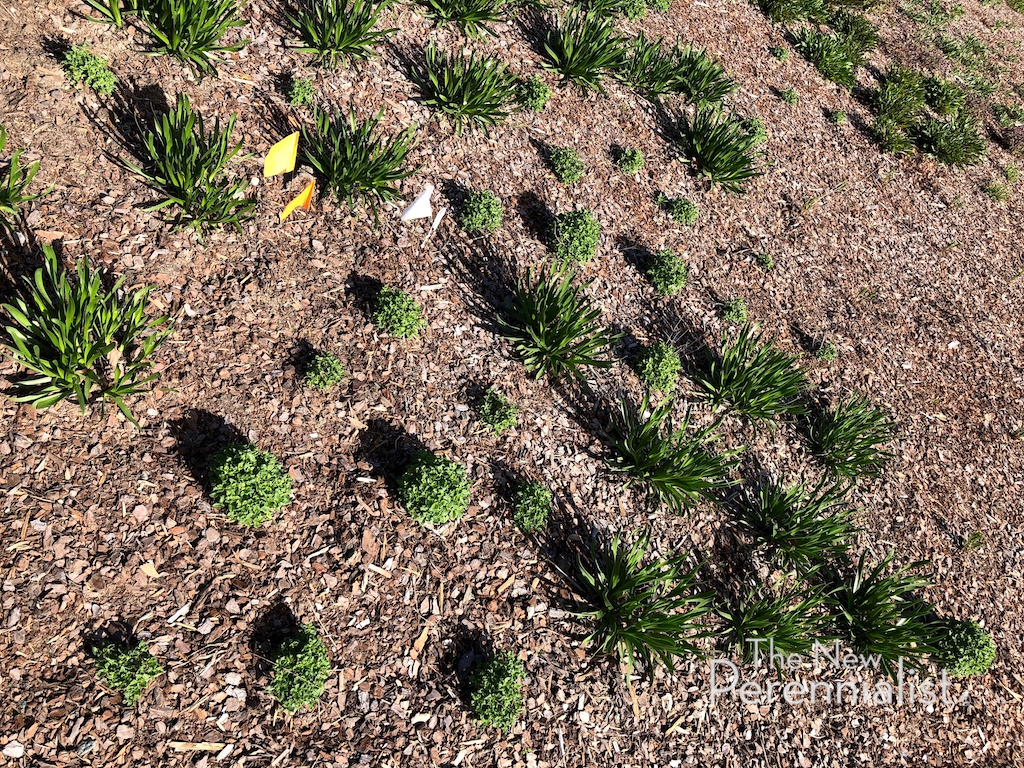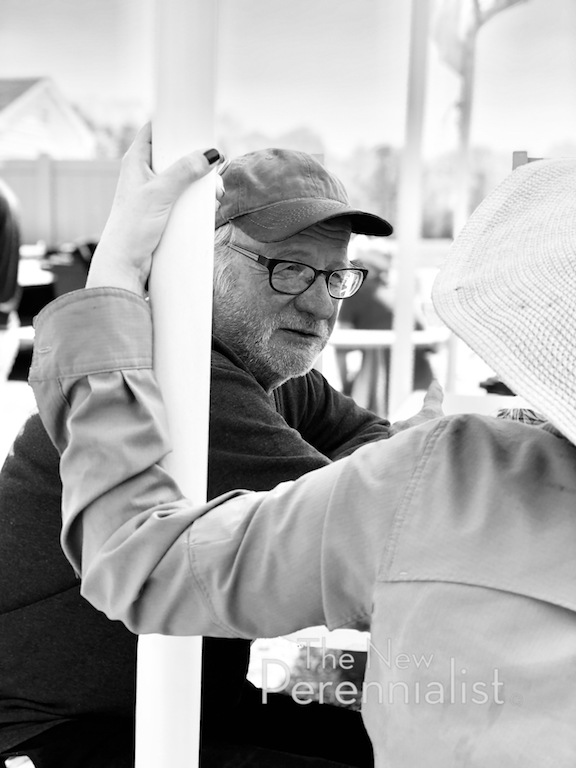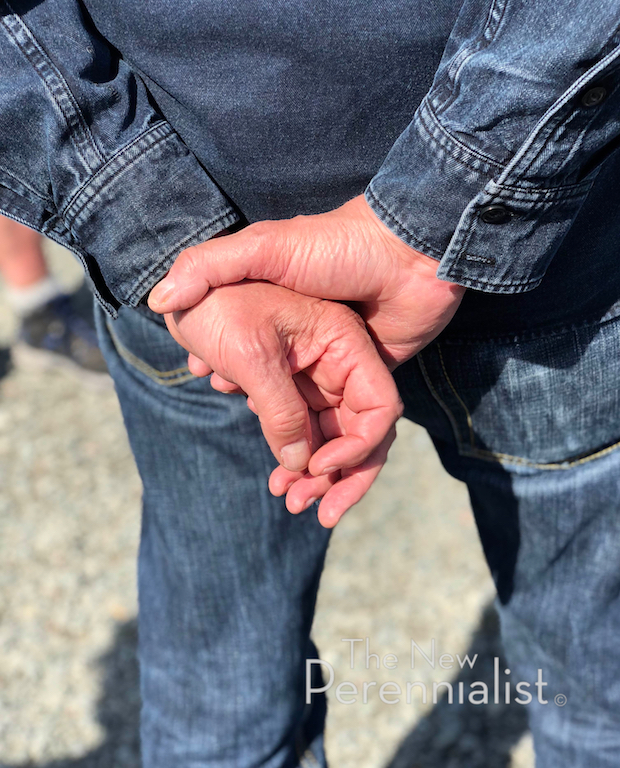My trowel almost didn’t make the trip.
“Sir, what is the long sharp metal object in your suitcase?” Damn, the x-ray at YYZ airport security in Toronto had found me out. “Well,” I replied. “It’s a garden trowel for planting flowers.”
The security officer picked up an imaginary trowel and made violent stabbing motions in the air. “Sorry sir, it could be used as a weapon.”
“Well, perhaps so,” I knew better than to argue, “but honestly, I use it to dig in plants.” The officer whispered back and forth with his superior and then finally, motioned for me to pick up my bag with the trowel amazingly still inside. “You’re free to go, sir.”
I pursed my lips in quiet victory. At the ungodly hour of 5:30 a.m. on a Friday morning in April, my trowel and I glided through U.S. Customs to dig into my New Perennial opportunity of the year: a chance to help plant out a Piet Oudolf-designed botanic garden in Delaware.



Piet Oudolf: Feet on the ground
One week later standing in his future meadow, I had the chance to ask Piet Oudolf himself that most basic of questions: “So Piet, how do you actually like to plant?”
In response, Piet took my security-approved trowel and bent down to reach the sandy soil in the bed below. He dug down on a steep angle and flipped the earth sideways in one smooth action, quickly preparing the hole for planting in just a few long-practised strokes.
He explained, “Our trowels have a different shape, more rounded at the tip, but this is how I do it. Sometimes with a pulling motion.”
It was a timely demonstration by the remarkably down to earth Dutch plantsman, whom as a planting designer seems to travel in a creative orbit all his own.

I’d spent the past few days planting with a supergroup of 25 volunteer garden professionals who’d streamed in from all over the US, Canada, and from as far way as Lithuania, to help plant up 16,500 perennials to complete the second phase of Piet’s two-acre dream meadow.
Working against chilly coastal winds, sandstorms, and a three-day timeline, we’d collectively drilled, dug, and planted using augurs, trowels, hori hori knives, and wheelbarrows, all to get the plants in the ground.


Now on the final day, the heat kicked up to broil and Piet himself had arrived to survey our collective work and make field adjustments with trusted plantsman Roy Diblik and the rest of the planting team.
With expectation in the air, we all walked out to the two-acre meadow site led by DBG horticultural director Gregg Tepper and project organizer/designer Barbara Katz.
Hands clasped behind him like a sea admiral on deck, Piet’s eyes searched and roamed over the figure-eight shaped meadow divided up with immense sweeps of perennial block planting intercut by swirling matrix patterns.
The first section planted last year already showed an early green flush of growth while the freshly-planted areas looked more like stubble.
“Feels good,” Piet nodded approvingly. And tracing his hand in the air over the interwoven panoply of patterns to indicate the future meadow, he murmured with quiet praise, “You can see it.”

Head in the clouds
For everything I might know about Piet’s approach to planting design, it’s another thing entirely to translate one of those designs into reality on such a grand scale, involving thousands of plants and dozens of volunteers.
The sheer level of complexity is both dazzling and humbling.
Piet’s master plan for Delaware more resembled a hyper-detailed street map for some amoebic alien world, imprinted with a dialect of shapes, batwings, icons, dots and x’s, all to mark the exact spots where the plant groupings will go.
As I discovered on-site, the more deeply you stare into the plan, the more you begin to see. It’s all about the intricate web of plant relationships designed to attract people and wildlife in equal measure.


Planning + preparation + process
It takes an incredible amount of energy and planning to mount a project on this scale. In Delaware, that’s the role of Gregg Tepper and Barbara Katz who have taken care of all the major logistics from sourcing plants to organizing the planting itself.
We see them here in discussion on day one of the project.

The local volunteers got everything ready before we even showed up – they prepared the site and soil in the planting areas with a thick layer of pine mulch to protect the ground from weeds and conserve moisture.
The first step in the actual planting is to transpose the design patterns onto the ground in scale with the plan.
In Delaware, this was the job of Piet’s go-to team of Roy Diblik and Austin Eischeid who used spray-guns to mark the outlines on the ground in orange paint.
Their technique was to mark off the measurements on the edge of each bed as per the plan and then spray in the flying abstract shapes and blobs that fill the various sections of the Sporobolus (Prairie dropseed) matrix.
Once they liked the outlines, they’d spray in the short form plant name to keep track for later. The ground is forgiving: if Roy didn’t like the shape he’d painted, he’d rub it out with his shoe and start again.
The final part of the set-up was to mark every single planting area with a matching pair of plastic survey flags on which was hand-written both the botanical name and the precise number of plants for that spot.


Right plants. All the right places.
Piet’s dream plant list for the Delaware site is comprised of 85% native perennials and grasses with the remainder non-natives.
The total site calls for approximately 65,000 plants to be planted in three phases. All 16,500 plants for this second phase had been transported to the site a few days prior with a pop-up plant nursery set up beside the meadow, complete with an alphabetic row by row listing of all the perennials and grasses used in the planting.
Working on such a massive scale, it takes serious logistics to get the right number of plants to the right places – especially with dozens of volunteers running around every which way.
New York designer and hori hori knife planting ninja, Naomi Brooks devised a failsafe system using two flags so that one person parked themselves in the exact spot in the bed, while another took a flag to the nursery to retrieve the exact number of plants for that spot. That could be three asters or 47 Muhlenbergia – the trick was to get it consistently right.


Laying out
Once the plants were roughly laid into place, Roy and Austin laid the plants out more finely – using tight spacing (averaging around 10–12”) with an asymmetrical feel to give it a natural flow. It’s an intangible art and not just anyone can do it.
From this point, the planters took over with assembly line speed and precision, starting with augurs to quickly drill out holes for the pots in each section.
(Yes, that’s me below grinning like an idiot while doing my bit on the augur.)


They were followed by planting teams who followed Gregg Tepper’s detailed instructions to the letter: First, remove the plant from its pot, rough up the rootball with your fingers or knife, scrape off the top layer of soil to remove weed seeds left over from the nursery, and then place it in the earth at soil level or lower. There is no need to firm in the soil around each plant.
As a final touch in matrix-style planting, Piet adds small random groupings of scatter plants to create a spontaneous sense of flow and repetition.
His scatter plant list for the DBG includes Echinacea pallida ‘Hula Dancer’, Gentiana andrewsii, Geum triflorum and Monarda punctata. These were laid out as plugs by Roy and Austin and then planted by trowel or hori hori knife.
Once everything was finally in the ground, Gregg Tepper assisted by a couple of volunteers carefully lifting the hoses, watered all the plants in to firm and eliminate air pockets without compacting the soil.

Calling all Dreamers
Whatever drew us all to Delaware?
It’s a testament to the power of Piet and his work that inspired us to drop everything at one of the busiest times of the year to be part of something bigger than ourselves.
The out-of-town crew of volunteers included landscape architects, planting designers, horticulturists, nursery growers, even an up and coming lady wrestler named Emmy Lou.
Some worked on the first phase of the planting last year and loved the experience so much, came back for more.
Many of us are linked through social media but had never met in what I call ’the reality’. It’s often a revelation in this day and age to all meet up in the same time and place.
When Piet arrived, he joined us at the house, which gave us a fantastic opportunity to catch up at the start and the end of the day. I plan to report on our conversations in a future post.
Ultimately, for a lone-wolf gardener like myself, the volunteer experience came as something of a revelation – to work communally as part of a larger group.
Everyone involved contributed towards making the garden come to life. That’s especially true of the local volunteers in Delaware who will become the future stewards of the garden and critical to its long-term success.
The DBG organizers kindly hosted us at a roomy AirBnB house a short drive from the site, with a rotating cast of garden folk changing up as the week wore on.



The Oudolf touch: Try this at home
I’m endlessly fascinated by the intangibles in Piet’s gardens that seem to elevate them from their peers. One of the more elusive aspects is how he creates the feeling of unforced spontaneity in his extremely detailed planting designs. It’s akin to the Japanese idea of wabi-sabi – or the beauty of imperfection.
I discovered in Delaware that it also comes down to decisions made right at the planting stage – to give them a certain naturalistic feel. (I’ve yet to read about these methods in any book.)
For example: When doing block-style planting, Piet applies the principle of feathering to knit or blend together together different blocks. Rather than simply lay out the plants inside each block in a straightforward manner, you intermingle a few of the plants to create an asymmetrical edge.

This part of the planting (completed the previous year) shows the effect with an interplanting of grassy Allium ‘Summer Beauty’ with Calamintha nepetoides.

Look at how the two blocks are flowing into each other to blur the lines between. By the time it matures, the effect will be loose and spontaneous.

The final dig
We spent the final morning digging in more scatter plants as Piet looked on from under an umbrella to shield the sun.
Roy Diblik turned to me and asked, “Tony, can I borrow your trowel?”
“Well of course, Roy.”
The veteran plantsman knelt to the ground in his Red Wing boots now spray-painted orange by marking the layout in the wind.
In effortless rhythm, he prised open the earth with the trowel, gently eased in the plug, and then firmed the soil around it. Bang. Done. It was over before you even knew he began

Walking through the Philadelphia airport to catch my flight home, I wondered if that first security officer was right.
Could my red-handled trowel really be a weapon after all?
Now waiting in the long security line, I took my turn to remove my shoes and belt, place them into security boxes and put my carry-on luggage on the conveyor belt.
I could sense what was coming.
The security officer stopped me in my tracks, “Excuse me, sir. Exactly what is the device inside your carry-on?”
I said, “It’s a garden trowel and I just used it to help plant a new garden.”
“Well, next time”, the officer said, “just remove it from your suitcase, place in the tray, and it should be fine.”
Surprised by the change in attitude, I smiled and nodded. My trowel was a powerful weapon indeed. Not for cartoon-stabbing my fellow passengers, but to bring new life into being and create a greater beauty beyond the world we normally see.
A weapon to change the earth one small handful at a time.
This is what I was taking home.

The Red Trowel
So much depends
upon
a red garden
trowel
dusted with sand
beside the green
mounds
* With apologies to William Carlos Williams
Delaware Botanic Gardens at Pepper Creek

Master Plan: Robinson Anderson Summmers Landscape Architects
Infrastructure design by Lake/Flato
Piet’s two-acre meadow of herbaceous perennials and grasses is now the multi-seasonal centrepiece of the Delaware botanic gardens, set on a 37-acre section of coastal plain on the Delmarva Peninsula.
Previously farmed for soybean, the meadow site has full sun and free-draining sandy loam, similar to Piet’s home in the Netherlands. The meadow is bordered on two sides by woodland edge leading into a tracery of paths winding through 33 acres of coastal deciduous forest. These areas were selectively cleared and imaginatively developed by former Hort Director Gregg Tepper and his team of volunteers. More recently, Gregg has moved on to a new position at the Laurel Hill Cemetery closer to his home in Philly.
Open as of Fall 2019, the DBG vision is to create a sustainable wildlife-friendly public botanic garden to attract visitors and residents inland from the nearby Delaware coast.
==
Special thanks to Designers Lori Johnson and Naomi Brooks for giving this Canadian writer a lift to Delaware while seeing some remarkable gardens along the way.

Excellent post. Thanks for letting those of us who couldn’t make it, live and learn vicariously through your writing. Really looking forward to visiting this space!
Such a fascinating post, Tony. A lovely travlogue as well as a planting insight. I especially liked the illustration of the feathered planting blocks which was very informative.
Beautiful and Inspiring. Thank you for the detail and photos!
I enjoyed getting your insights into the installation process. Kind of reminds me how it went with a Patrick Blanc vertical wall installation here in San Francisco that I was part of some years ago.
Thanks David. Patrick Blanc must be a trowel of a whole different colour!
love landscape, love this garden!and love you all!